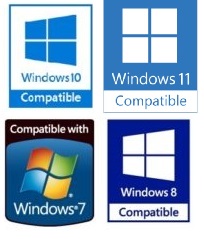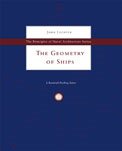Automated Variation of Hull Form
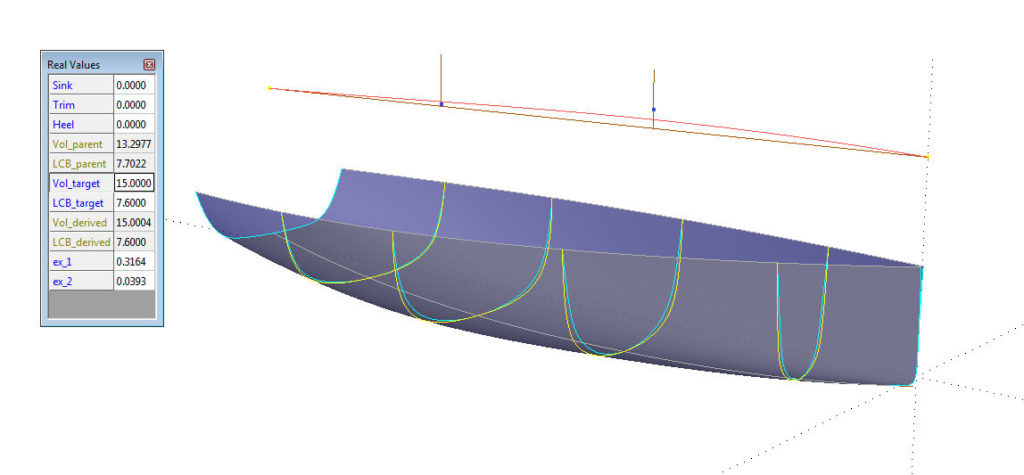
by Reinhard Siegel
- Parent hull
- Derived mastercurves – basic principle
- Derived hull
- Longitudinal variation of mastercurve deviation
- Automated adjustment of derived mcs for target values of volume and LCB
- Export of derived hull
- Import of parent hull
Appendix 1
On systematic variation of hull forms – the Lackenby method
Appendix 2
On automated adjustment of hull form – mastercurve relocation
Introduction
The design of a hull form is an iterative process. This process must converge. The iterative steps must therefore be smaller and smaller, the hull shapes are becoming more similar. Inevitably, the point is reached where the shape meets the requirements, only the displaced volume could be a little larger, for example, and it would be nice if the LCB is a few centimeters more aft. Otherwise everything fits. Then
the mastercurves must be changed a few millimeters here and there, while checking permanently hydro-statics and fairness. This fine tuning is time consuming.
The approach described below makes it possible to automatically generate new mastercurves from the mastercurves of an existing hull so that target values of volume and LCB are obtained. Fairness, the out-er contours of the hull and the overall hull form character are preserved.
This tutorial was inspired by the study of H: Lackenby’s method, which is reported in the appendix.
Developable Surfaces in MultiSurf
 Hull, Deck, and Superstructure
Hull, Deck, and Superstructure
by Reinhard Siegel
Whenever the manufacturing capabilities of the builder and/or economic reasons are taken into account in the construction of a boat the chine hull is selected. Chine form hulls are not commonly looked upon with pleasure and in contrast to round bilged hulls their resistance is increased. However, since the beau-ty of a boat is mainly defined by her proportions, it should be possible to design chined hulls without ne-glecting aesthetics. And as far as performance is concerned, especially when using multiple chines, hull forms can be created that are hardly inferior to the round bilge competition. In fact, at high speeds (powerboats) the chined hull is superior to the round bottom version in terms of resistance and sea behavior.
Not every chine hull automatically features developable surfaces. It is a common misconception to be-lieve, that a hull with sections that run straight between sheer, chines and keel is made up of developable surfaces. On the contrary, deck side, chines and profile as curves in space must be shaped to meet very specific conditions, in order to span them with developable fair surfaces.
What might ultimately decide whether to build a hull of the chine form type, there is no reason not to use the advantages of a surface kind, which is employed successfully throughout the technology.
Developable surfaces can be used easily for hull skin, deck and superstructures. They enable even the amateur to save material, cost and time to create a good product.
How to Create Computing MultiSurf Models
Variables, Formulas and Functions
by Reinhard Siegel
 Introduction
Introduction
There are two ways to specify a real number in the definition of an object: with a constant value or a real entity. Variables and Formulas are example of real entities. A Variable carries a value that lies within a specified range. A Formula involves an expression made of real entities, constants, operators and Functions. Variables and Formulas can be parents of all objects depending on a real value.
What are the advantages of Variables and Formulas?
With Variables and Formulas simpler, clearer models can be created. Models can be changed immediately, you do not have to search for the point that controls a certain part of the construction, one can directly select the variable in the Entities manager and then change its value. Example I-beam: for the given basic geometry just 4 measurements determine the shape. Using Variables and Formulas the coordinates of necessary auxiliary points do not need be individually constructed, their coordinates can be determined by calculation.
Variables and Formulas can be used to create models that carry out calculations: main dimensions, area sizes and center of gravity, rating rule measurements, floating position, hydrostatic characteristics, hydro-dynamic resistance and so on. In this way, a model can provide additional information to the designer about itself, always updated immediately upon a change of model shape.
Variables and formulas expand the functionality of MultiSurf enormously. MultiSurf is limitless.
Decks and Superstructures
On decks, trunk cabins and bubbles
by Reinhard Siegel
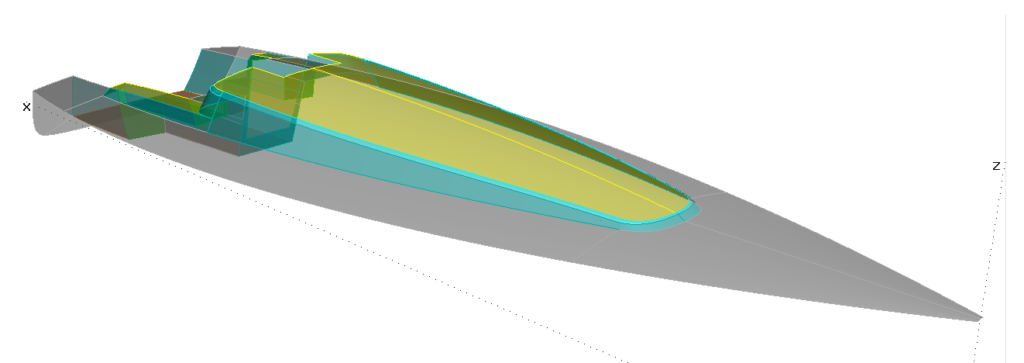 Introduction
Introduction
Small boats have no deck or cabin, but those are indispensable parts of larger vessels. This article describes various methods to model surfaces for decks and superstructures in MultiSurf.
Fitting Surfaces to Predefined Shapes
How to create a MultiSurf model from a paper lines plan
by Reinhard Siegel
Introduction
When you create a new design from scratch, you have complete freedom to shape the surfaces, and when all looks pretty and satisfies the design parameters you can quit. This is “freeform design”. But if the objective is to reproduce a predefined shape it comes to “surface fitting”. The freedom to shape is re-placed by the challenge to create a geometry which is close to the given data as well as being fair. In this article we will discuss the required steps how to safely overcome this exercise in MultiSurf. (Click on the image for the full document)
On the rounding of bows, sterns, sharp waterlines and on the attachment of keels
How to make a B-spline Lofted Surface touch another surface
by Reinhard Siegel
Introduction
There are many situations in the modeling of the geometry of hulls and superstructures, where a basis surface requires some rounding. Being small in proportion there are no sophisticated freeform requirements, except to look nice and touch adjacent surfaces smoothly.
This article shows methods how to employ the surface type B-Spline Lofted Surface for a fair attachment of classic hull keels, to round the bow or the stern of a hull, to remove sharp waterline entries. Its aim is to explain the pros and cons of various procedures, so in the end you can decide which method will suit your needs best.
On Modeling Classic Sailing Yacht Hulls
Some variations of the round bilged hull theme
by Reinhard Siegel
Introduction
The hull shape of a classic sailing yacht is more complex than the hull of a modern sailing boat: long bow and stern overhang, full, easily turned garboards, rudder attached to keel trailing edge as a flat piece or being part of the keel surface as a flap. Boats of the Dragon class, meter class yachts or traditional long keel sailing cruisers are examples of the hull type in question.
This article has in view to show methods how to create classic yacht hull forms in MultiSurf. It is not about designing a hull with specific dimensions and shape, but explains the pros and cons of various procedures, so in the end you can decide which method will suit your needs best.
Modeling a Rudder in MultiSurf
Strategies and methods
by Reinhard Siegel
Introduction
This article presents several methods how to create a rudder. It is not about designing a rudder of specific dimensions and shape, but shows what methods are available and which strategy is practical for your purpose.
Modeling Round Bilge Hulls
C-Spline Lofted Surface and the vertex curve method
by Reinhard Siegel
Introduction
This article shows on the basis of the model sy15.ms2 by what considerations the author creates a round bilge hull in MultiSurf. This is not about making a hull with specific dimensions or shape features. But it comes to show which method is practical, so in the end it is on the screen what you imagine.
Round Bilge Hull With Full Length Chine
A simple variation of the round bilge hull theme
by Reinhard Siegel
Introduction
Modern racing yachts feature a single longitudinal chine. On some boats it runs from stem to stern, on others it is of partial length. According to the motto: what is right for a racer cannot be wrong for a cruiser, there are more and more boats with this hull form characteristic.
On the basis of the model sy15_full_chine.ms2, this article shows how to create a hull with a full length chine in MultiSurf. This is not about making a hull with specific dimensions, but shows which method is practical, so in the end you achieve what you intend.
Round Bilge Hull With Vanishing Chine
A complex variation of the round bilge hull theme
by Reinhard Siegel
Introduction
Modern racing yachts feature a single longitudinal chine. On some boats the chine runs full length from stem to stern, on others it starts at the stern, but vanishes somewhere forward of the middle of the hull.
In this article I would like to explain on the basis of the model sy15_vanish_chine.ms2 how to create in MultiSurf a round bilge hull with a partial length chine, which proceeds from the stern. This is not about making a hull with specific dimensions, but shows which method is practical, so in the end you achieve what you imagine.
Vanishing Spraychine
On Hullform Characteristics
by Reinhard Siegel
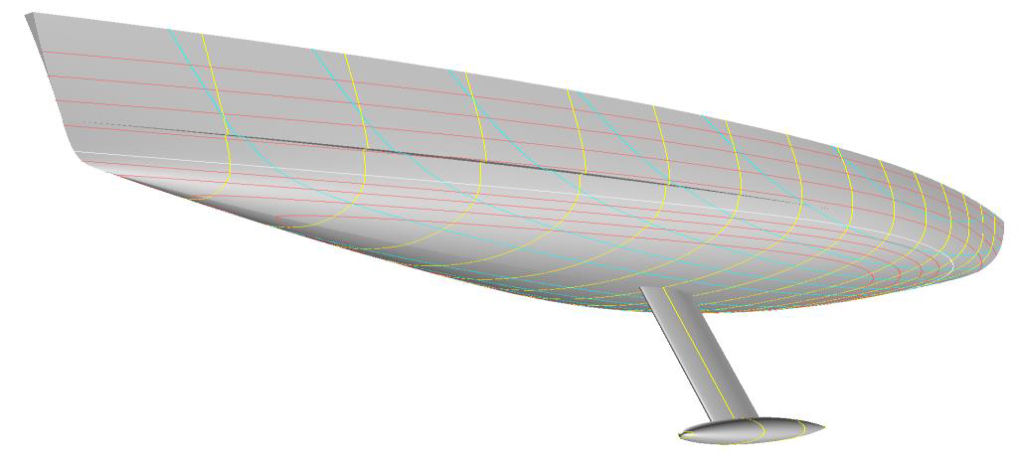
Vanishing spraychine
Introduction
Some boat hulls feature a partial length spraychine in their forebody topside surface. This form characteristic is closely related to the partial length chine. There is not just a break but a real step in the run of transverse cross sections. Beyond begin and end of the vanishing spraychine the hull surface is smooth and free of breaks.
On Modeling Ship Hull Forms in MultiSurf
by Reinhard Siegel
Introduction
An evident form characteristic of ships, such like cargo vessels, container carriers or cruise liners is, that portions of the hull surface are flat. Many ships also feature a parallel midbody, i. e. a sequence of cross sections is identical. Common to ships is also the bulbous bow. This article deals with methods how to model those hull forms. It is not about designing a hull with specific dimensions and shape, but explains the pros and cons of various methods.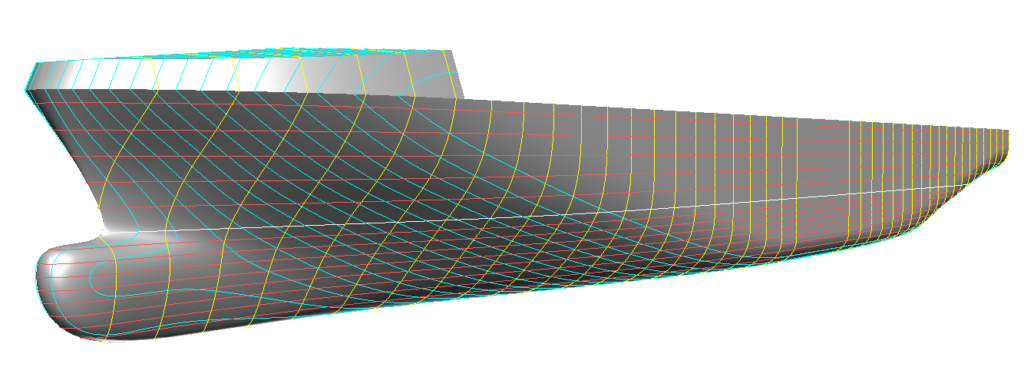
The Use of Components for the Modeling of 2D Structural Parts in Hull Construction
On the creation of a frame in the aftbody of a metal powerboat
by Reinhard Siegel
Introduction
Let us assume we have made the geometry of a standard metal powerboat: surfaces for hull and deck. And we went beyond this ordinary extent and have also added a series of longitudinal frames (stiffeners) to support topside, bottom and deck. Next we would export sections and continue in a cad program in order to define all the flat structural parts required for the construction of the boat. But this means: the world of relational geometry is left. If there will be any change of the model, the cad drawings must be adapted. And certainly, there will be changes. In the following it is shown by the example of a transverse frame, that there is no need to leave MultiSurf for the creation of complex flat parts.
Chine-Form Powerboat Hulls
A further variation of the C-spline Lofted Surface theme
by Reinhard Siegel
Introduction
Powerboats show more complex hull shapes then sailing boats. Chines, steps in the topside, tunnels in the bottom, transverse bottom steps, to name a few geometry form properties.
In this article I would like to explain on the basis of the model pb10.ms2 how to create in MultiSurf a standard chine form hull for powerboats. This is not about making a hull with specific dimensions, but shows how the C-spline Lofted Surface can also be used advantageously for this kind of hull shapes.
On Keel Ballast Bulbs
Strategies and Methods
by Reinhard Siegel
Introduction
Sailing yachts require stability to counter-balance sail forces. Mono-hulls rely on keel ballast. On classic hulls the ballast is part of the underwater body. Cruisers show separate ballast keel appendage, some with a distinct increase in thickness towards the tip. Performance cruisers and racing yachts feature a keel fin with attached ballast bulb.
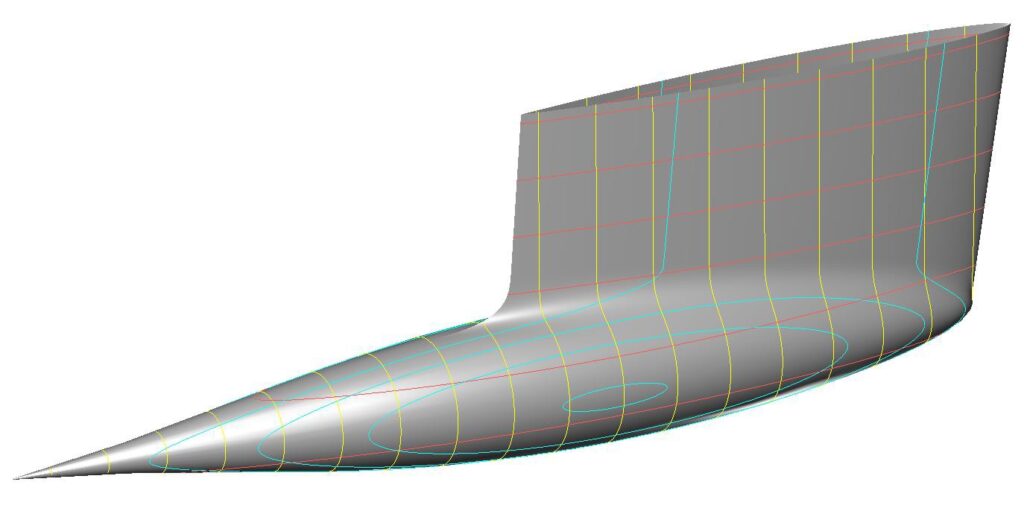
This article shows how to create keel ballast bulbs in MultiSurf. This is not about making a bulb with specific dimensions or shape, but shows which method is practical for the specific purpose.
B-spline Curves and B-spline Surfaces
Properties and Applications
by Reinhard Siegel
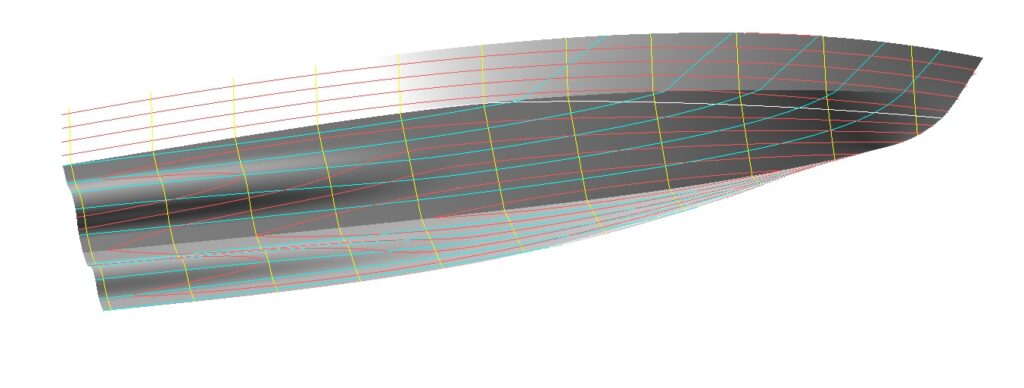
Introduction
B-spline Curves in MultiSurf are easy to shape with a few control points, they do not oscillate, they always start and end in the same way. These geometric properties turn them into very practical freeform curves, for example as master curves for hull, deck or superstructure. B-spline Surfaces as their extension also have these geometric features. The following sections will show how B-spline Curves and B-spline Surfaces can solve many geometry tasks.
Form Features
About particularities of geometry of hull, deck and keel
by Reinhard Siegel
Introduction
Form features are special properties of geometry that, from the designer’s perspective, are necessary for the functioning of his design. For example, a full length chine in the hull surface, a tunnel in the bottom, a characteristic hull-deck rounding. In the following, methods are described of how frequently required shape properties of hull, deck and keel can be modeled. Some designs have been covered in previous tutorials. However, they are listed here to create a comprehensive collection.
The Solve Set Entity
About iterative solutions of geometry problems
by Reinhard Siegel
Introduction
There are geometry problems that are not easy to solve. For example, construct a line that runs through a certain point and is tangent to a circle. Or you can determine the maximum width of a curve or a trunk. You can try to approximate these geometrical constructions manually, but you have to repeat them if the basic geometry changes. MultiSurf offers a permanent, fixed solution for such geometry tasks – the entity Solve Set.
This tutorial was inspired by a MultiSurf user who asked how the waterlines of a boat hull can be rounded elliptically at the bow. The solution to this geometry problem makes it necessary to determine the point of contact between waterline curves and elliptical arcs. In order for this to be a permanent part of the model, a special entity must be used – a Solve Set.
As an introduction to the topic of Solve Sets, two simple examples are considered first. Then it is examined how the center and radius of a circle that touches a curve can be determined. Based on this, the point of contact between an ellipse and a curve is determined in order to then answer the question of the elliptical bow rounding. Finally, two examples are used to show how Solve Set objects can be used to determine the free floating position of a hull and to vary the shape of the hull for target values of dis-placement and LCB.
Components
Part 1 – Basics and Examples
by Reinhard Siegel
Introduction
No design looks like the other. But boats, yachts and ships are similar. With components one can save time and effort. A component is a piece of coherent MultiSurf geometry that can be inserted into other models. Instead of creating in the work model the prefered construction for keel, rudder, deck, transom etc. each time entity by entity, they can be inserted with little effort using components.
With components, the structure of a model can be clearly arranged. A component can be used to detach a related group of entities from a large model, edit it in a separate model and insert it into other models.
This tutorial is aimed to explain how to load components into a model, how to create them, which tools are available. In part 1 the tutorial will introduce a number of components that are practical when building the geometry model of a boat. Part 2 will show numerous components to give models a realistic appearance.

Components
Part 2 – Deck Equipment and Miscellaneous
by Reinhard Siegel
Introduction
Part 1 of the component tutorials covers how to create components, load them into a model, and the tools available to do so. A number of components that come in handy when building a boat model are presented. Here in part 2 deck equipment components are shown, with which models can be given a realistic appearance. Also deck components and two other components that can be beneficial for solving certain geometry problems.

Three Modeling Exercises
Catamaran hull, multi-concave hull bottom, Swath ship: pod-strut transition
by Reinhard Siegel
Introduction
This tutorial, inspired by a MultiSurf user, is about modeling the geometry of a catamaran hull, a multi-concave bottom of a powerboat and the transition between two surfaces. It deals with the creation of characteristic form features, to generate models with specific main dimensions is not the purpose.




